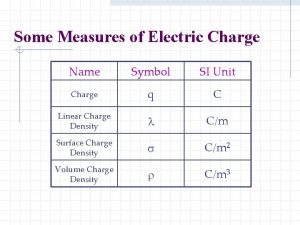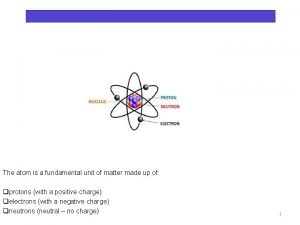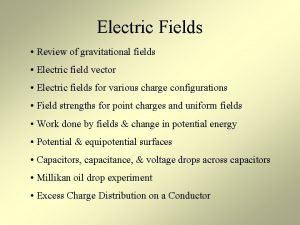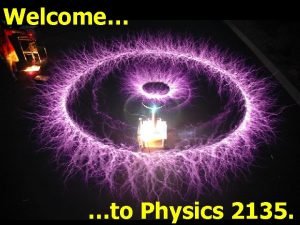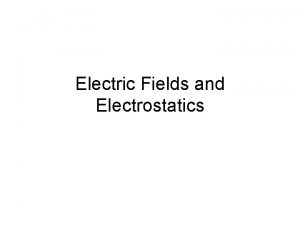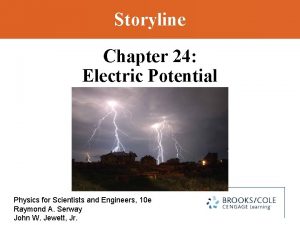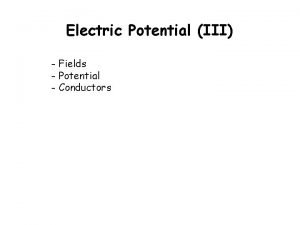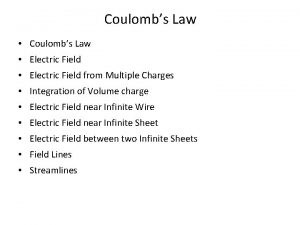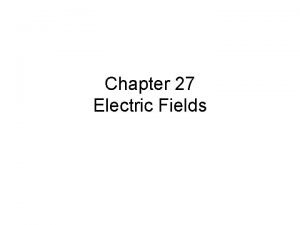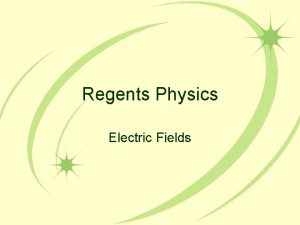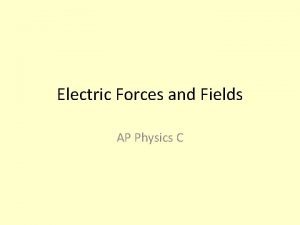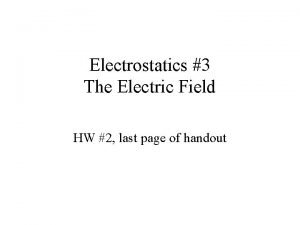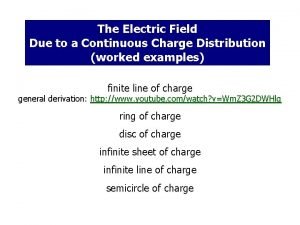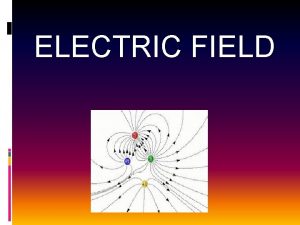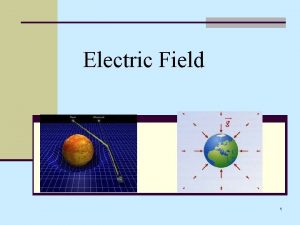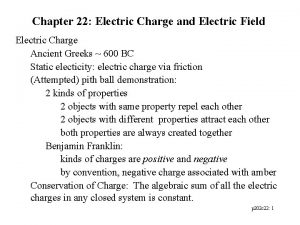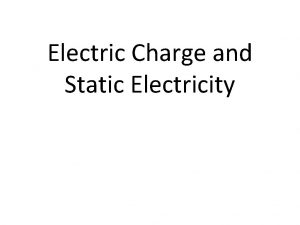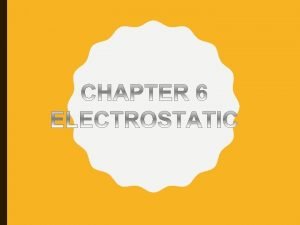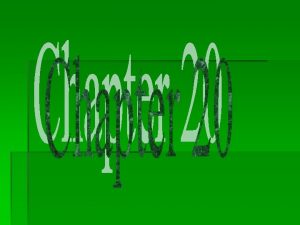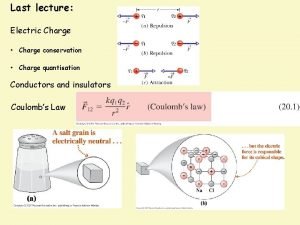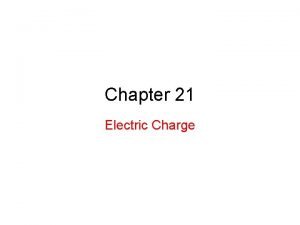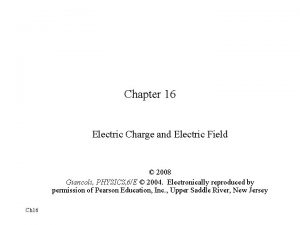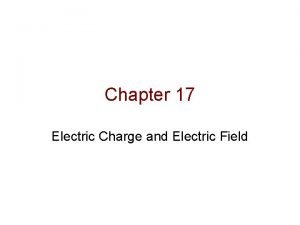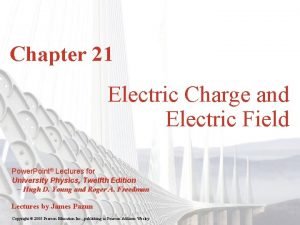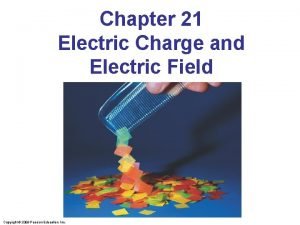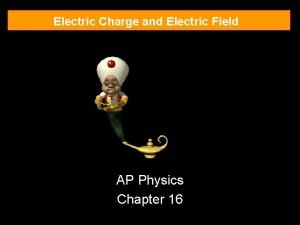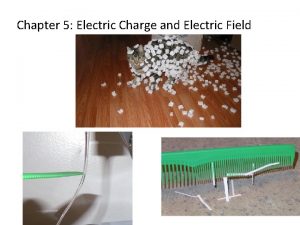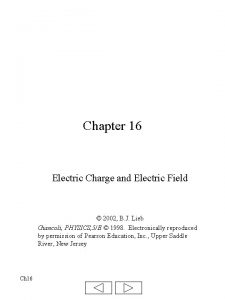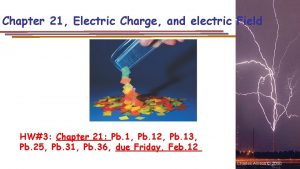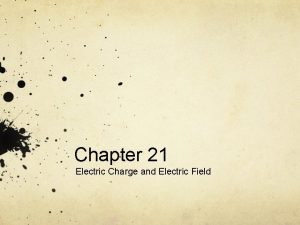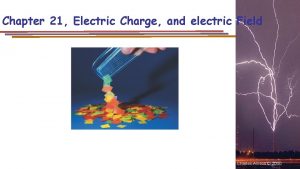Chapter 16 Electric Charge and Electric Field Units






























- Slides: 30

Chapter 16 Electric Charge and Electric Field

Units of Chapter 16 • Static Electricity; Electric Charge and Its Conservation • Electric Charge in the Atom • Insulators and Conductors • Induced Charge; the Electroscope • Coulomb’s Law • Solving Problems Involving Coulomb’s Law and Vectors • The Electric Field

Units of Chapter 16 • Field Lines • Electric Fields and Conductors • Electric Forces in Molecular Biology: DNA Structure and Replication • Photocopy Machines and Computer Printers Use Electrostatics

16. 2 Electric Charge in the Atom: Nucleus (small, massive, positive charge) Electron cloud (large, very low density, negative charge)

16. 2 Electric Charge in the Atom is electrically neutral. Rubbing charges objects by moving electrons from one to the other. e- deficient = positively charged excess e- = negatively charged

16. 2 Electric Charge in the Atom Polar molecule: neutral overall, but charge not evenly distributed

16. 3 Insulators and Conductors Conductor: Insulator: Charge flows freely Almost no charge flows Metals Most other materials Some materials are semiconductors.

16. 4 Induced Charge; the Electroscope Metal objects can be charged by conduction:

16. 4 Induced Charge; the Electroscope They can also be charged by induction: ground is an infinite supply of whatever charge is needed to neutralize a charge imbalance ground can “sink” or “source e-

16. 4 Induced Charge; the Electroscope Nonconductors won’t become charged by conduction or induction, but will experience charge separation: A simulation: http: //phet. colorado. edu/simulations/sims. php? si m=Balloons_and_Static_Electricity

16. 5 Coulomb’s Law Experiment shows that the electric force between two charges is proportional to the product of the charges and inversely proportional to the distance between them.

16. 5 Coulomb’s Law Coulomb’s law: (16 -1) This equation gives the magnitude of the force. Compare to the gravitational force. Einstein tried to combine the 2 in his Grand Unification Theory.

16. 5 Coulomb’s Law The force is along the line connecting the charges, and is attractive if the charges are opposite, and repulsive if they are the same.

16. 5 Coulomb’s Law Unit of charge: coulomb, C The proportionality constant in Coulomb’s law is then: Charges produced by rubbing are typically around a microcoulomb:

16. 5 Coulomb’s Law Charge on the electron: Electric charge is quantized in units of the electron charge.

16. 5 Coulomb’s Law Coulomb’s law strictly applies only to point charges. Superposition: for multiple point charges, the forces on each charge from every other charge can be calculated and then added as vectors.

16. 6 Solving Problems Involving Coulomb’s Law and Vectors The net force on a charge is the vector sum of all the forces acting on it.

16. 6 Solving Problems Involving Coulomb’s Law and Vectors Vector addition review:

16. 7 The Electric Field The electric field is the force on a small charge, divided by the charge: (16 -3)

16. 7 The Electric Field For a point charge: Force on a point charge in an electric field:

16. 8 Field Lines The electric field can be represented by field lines. These lines start on a positive charge and end on a negative charge.

16. 8 Field Lines The number of field lines starting (ending) on a positive (negative) charge is proportional to the magnitude of the charge. The electric field is stronger where the field lines are closer together.

16. 8 Field Lines The electric field between two closely spaced, oppositely charged parallel plates is constant.

16. 8 Field Lines Summary of field lines: 1. Field lines indicate the direction of the field; the field is tangent to the line. 2. The magnitude of the field is proportional to the density of the lines. 3. Field lines start on positive charges and end on negative charges; the number is proportional to the magnitude of the charge.

16. 12 Photocopy Machines and Computer Printers Use Electrostatics Photocopy machine: • drum is charged positively • image is focused on drum • only black areas stay charged and therefore attract toner particles • image is transferred to paper and sealed by heat

16. 12 Photocopy Machines and Computer Printers Use Electrostatics

16. 12 Photocopy Machines and Computer Printers Use Electrostatics Laser printer is similar, except a computer controls the laser intensity to form the image on the drum

Summary of Chapter 16 • Two kinds of electric charge – positive and negative • Charge is conserved • Charge on electron: • Conductors: electrons free to move • Insulators: nonconductors

Summary of Chapter 16 • Charge is quantized in units of e • Objects can be charged by conduction or induction • Coulomb’s law: • Electric field is force per unit charge:

Summary of Chapter 16 • Electric field of a point charge: • Electric field can be represented by electric field lines • Static electric field inside conductor is zero; surface field is perpendicular to surface
 Chapter 21 electric charge and electric field
Chapter 21 electric charge and electric field Chapter 21 electric charge and electric field
Chapter 21 electric charge and electric field Units of charge
Units of charge Chapter 21 electric charge and electric field
Chapter 21 electric charge and electric field Difference between charge and electric charge
Difference between charge and electric charge Difference between charge and electric charge
Difference between charge and electric charge Linear charge density symbol name
Linear charge density symbol name Si unit of electric charge
Si unit of electric charge 21lwuy8i6hw -site:youtube.com
21lwuy8i6hw -site:youtube.com Electric field and magnetic field difference
Electric field and magnetic field difference Magnetic field
Magnetic field Properties of coulomb's law
Properties of coulomb's law Si unit of electric field
Si unit of electric field Electric field formula
Electric field formula Electric field units
Electric field units Electric field strength
Electric field strength Electric field of a finite line charge
Electric field of a finite line charge Electrostatics equations
Electrostatics equations Electric field of a finite line charge
Electric field of a finite line charge Electric field for infinite line charge
Electric field for infinite line charge Electric feild equations
Electric feild equations Electric field lines about a point charge extend
Electric field lines about a point charge extend Electric field of line charge
Electric field of line charge Force on charge in electric field
Force on charge in electric field Electric field due to a continuous charge distribution
Electric field due to a continuous charge distribution Electrical energy formula
Electrical energy formula Electric field electric potential
Electric field electric potential Electric potential
Electric potential Electrostatic potential energy definition
Electrostatic potential energy definition Chapter 17 section 1 electric charge and force answer key
Chapter 17 section 1 electric charge and force answer key Chapter 6 electricity section 1 electric charge answers
Chapter 6 electricity section 1 electric charge answers






